Seasonal variations of phosphorus species in the Tuohe River,China. Part I. Sediments*
XU Qing (徐青) , YU Xiaoping (余晓平) GUO Yafei (郭亚飞) DENG Tianlong (邓天龙) , CHEN Yu-Wei , Nelson BELZILE
1 Tianjin Key Laboratory of Marine Resources and Chemistry, College of Chemical Engineering and Materials Science, Tianjin University of Sciences and Engineering, Tianjin 300457, China
2 School of Architecture and Civil Engineering, Chengdu University, Chengdu 610106, China
3 Department of Chemistry and Biochemistry, Laurentian University, Sudbury, Ontario, P3E 2C6, Canada
Abstract Sediment cores were collected at an upstream site (Jintang) and a downstream site (Neijiang)in summer and winter in the Tuohe River, which is one of the five largest tributaries of the Changjiang(Yangtze) River in China. A sequential leaching procedure was applied to determine the concentrations of the different forms of solid phosphorus, including exchangeable phosphorus (Exc-P) as well as phosphorus associated with iron oxides (Fe-P), with aluminum oxides (Al-P), with apatite (Ca-P) and with the residual fraction (Res-P), as correlated with water content and total organic carbon. The seasonal variations and the vertical distributions of phosphorus species in sediments at both sampling sites demonstrated that: 1) total phosphorus (TP) in summer and winter were ranged between 1 313–2 330, 1 491–2 228 mg/kg in Jintang and 543–2 128, 603–1 175 mg/kg in Neijiang, respectively. It can predicated the pollution of TP in Jintang is serious than that in Neijiang both in summer and winter; 2) total inorganic phosphorus (TIP) was the dominant form of TP; 3) Ca-P was the main chemical forms of TIP in the sediments. Based on the profiles in sediments and bio-available phosphorus data, it revealed that bio-available phosphorus (BAP) represented only a minor portion (0.61%–3.59%) of TP, and the vertical distribution of soluble reactive phosphorus(SRP) in corresponding porewaters was more abundant in the upper layer of the sediment, which suggests that BAP may be converted to non-bioavailable phosphorus in deeper layer of the sediment of this dynamic system.
Keyword: phosphorus species; vertical distribution; seasonal variation; Tuohe River
1 INTR ODUCTION
In freshwater aquatic systems, phosphorus is considered as one of the most important nutrient elements for its role in relation to the growth of phytoplankton (Wang et al., 2006), but its excess loading from anthropogenic sources could cause eutrophication and vast phytoplankton bloom can then occur in oceans, lakes or rivers. Ryther and Yentsch (1957) found that phosphorus has a great influence on the growth of plankton communities.After the publication of that paper, the scientific community began to pay attention to the biogeochemistry of phosphorus in aquatic systems. In 1967, an International Symposium on Eutrophication was held in Madison, Wisconsin, USA. At that meeting, phosphorus was determined as the key and restrictive factor of eutrophication (Lund, 1967). In sediments, phosphorus exists under different forms that can be identified and classified using a sequential leaching procedure.
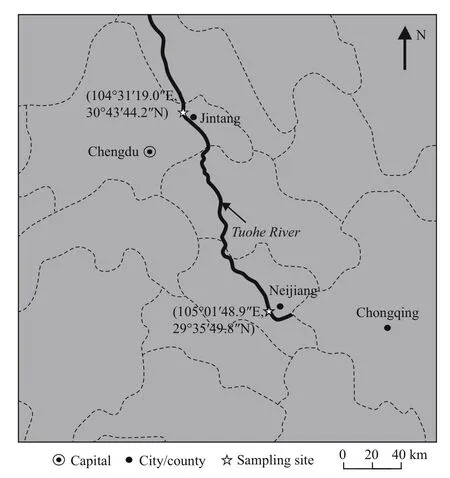
Fig.1 Sampling sites at an upstream Jintang (north) and a downstream Neijiang (south) in the Tuohe River
The sediment is the historical record of aquatic environments, and the interaction between sediment and overlying water via the sediment-water interface could allow the transport of phosphorus not only to this reservoir, but also make it a potential source to the overlying water. Therefore, the investigation of phosphorus species at the sediment-water interface is vital to understand the aquatic environment and the biogeochemical processes of nutrients.
The Tuohe River is one of the five largest tributaries of the Changjiang (Yangtze) River in China. In this study, two sampling sites named Jintang and Neijiang located at the upstream and downstream sections of the river, respectively, were investigated. A series of samples including the sediments and associated porewaters were collected from the two sites in the summer and winter seasons. The different forms of inorganic and organic phosphorus and their vertical distributions in sediments were measured in order to reveal the vertical distribution of different phosphorus forms in surface sediments at different seasons as well as the geochemical characteristics of various phosphorus species in surface sediments in this aquatic system.
2 EXPERIMENTAL SECTION
2.1 Site description
The Tuohe River, located in southwest China,flows through Chengdu, the capital of Sichuan Province (Fig.1), and constitutes one of the five largest tributaries of the Changjiang River. Samples were collected from the upstream in Jintang(104°31′19.0″E, 30°43′44.2″N) and the downstream in Neijiang (105°01′48.9″E, 29°35′49.8″N), in August 2006 and January 2007, respectively.
2.2 Sediments sampling
Sediment cores were collected by a diver using a PVC corer at the same sites where porewaters were collected at Jintang and Neijiang, making sure that the overlying water at the top of the core was clear and the surface of the sediment not disturbed. The overlying water was collected immediately in a 250 mL pre-cleaned polyethylene container. The sediments in the corer were sliced at each 1.0 cm and placed in pre-cleaned polyethylene containers using the method of coning and quartering. All sediment samples were stored in a glove-box bag filled with nitrogen gas to prevent oxidation and transported to the laboratory and kept frozen at -80℃ until analysis.
2.3 Analysis of moisture, Total Organic Carbon(TOC) and phosphorus species
To determine the percentage of moisture, about 5 g of sediment was put in a crucible and oven-dried at 105℃ for 24 h. The moisture content was calculated by weight difference. For TOC, about 0.5 g of dried sediment was heated in a muffle furnace at 750℃ for 4 h. After the sample has cooled down to room temperature in the desiccator, the weight difference was used to calculate the percentage of total organic carbon. Different fractions of inorganic phosphorus in sediments were extracted using the method of Zhu and Qin (2003). The extracted fractions can be classified as exchangeable-P (Exc-P), associated to iron oxides (Fe-P), to aluminum oxides (Al-P), to the apatite group (Ca-P) and to the residual fraction(Res-P) for the inorganic P and as organo-phosphorus compounds (Org-P). A flowchart of the sequential extraction for inorganic phosphorus in sediments is shown in Table 1. The total inorganic phosphorus(TIP), total organic phosphorus (TOP) and total phosphorus (TP) were measured using the Standards Measurements and Testing (SMT) method of the European Commission (Huang et al., 2004). The residual fraction (Res-P) was obtained from the difference between TP and TIP+TOP. The so called bio-available phosphorus (BAP) was estimated using the method of Liu et al. (2005) as 60% of the sum of Exc-P, Fe/Al-P and Org-P.
The concentration of the various phosphorus species in sediments was determined using the spectrophotometric method of phospho-molybdenum blue (Fang, 2004), which is described in detail in the Chinese National Standards Methods (GB 17378.4-1998). The detection limit of this method is 0.2 μg/L,and the precision of this method is 2.1%.

Table 1 The sequential extraction for inorganic phosphorus in sediments
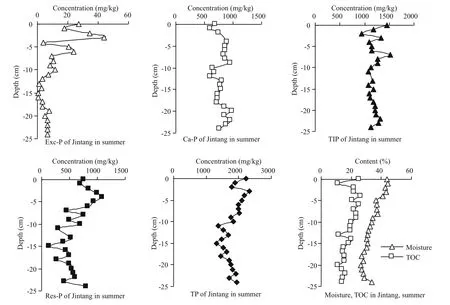
Fig.2 Profiles of phosphorus species, TOC and moisture content in sediment at the Jinta site of the Tuohe River in summer
3 RESULT AND DISCUSSION
3.1 Distributions of phosphorus species in sediment
3.1.1 Distribution of phosphorus species in sediment at the Jintang site in summer
Figure 2 shows that the concentration of Exc-P fluctuated from low background levels of 0.28 mg/kg to a maximum value of 43.7 mg/kg with a clear enrichment of Exc-P close to the surface of the sediment above -10 cm, with peaks appearing around-3 and -6 cm. The average concentration of Exc-P was 10.9 mg/kg, accounting for 0.9% of TIP. Although the Exc-P fraction is small, it is an important one since it is considered as the labile or available fraction of TIP that can be easily absorbed by aquatic organisms specifically because of the facilitated release of phosphorus from the sediment under the action of wind waves and benthic agitation. The moisture fluctuated from 26.6% to 44.2%, with an average value of 33.7%. TOC varied from 11.0% to 26.1%,with an average value of 18.4%, and both sets of values of moisture and TOC decreased with increasing depth.
It has been shown (Xu et al., under review) that many measured parameters of the sediments such as Res-P (0.643), TP (0.649), moisture (0.745), TOC(0.434) and dissolved sulfide (0.561) were correlated with Exc-P in Table 2, suggesting that there are many factors influencing the concentration of Exc-P in this milieu. The fraction Exc-P also showed a positive correlation of 0.589 with soluble reactive phosphorus(SRP), indicating that SRP and Exc-P influence each other in the vertical distribution of phosphorus in the sediment. The Exc-P content of the upper layer of sediment shows large fluctuations, but it tends to be more stable below -10 cm (Fig.2). It can be related to the high moisture content of the upper layer of sediment where the interchange of phosphorus species between the porewaters and the sediment occur frequently, although the effects of wind waves or bioturbation cannot be excluded. However, the high correlation coefficient existing between Exc-P and moisture (R=0.745) reinforces the possible role of porewater for exchange of phosphorus species from the sediments either to the overlying water or to the different sediment layer as very likely. We can also speculate from the good correlation coefficient between Exc-P and dissolved sulfide (R=0.561) that a portion of the phosphorus may be released from the Al-P and Fe-P fractions under the reducing environment and diffused into porewater, while another portion is re-adsorbed in surface sediment to become part of the Exc-P.

Table 2 Correlation coefficients ( R) among phosphorus species and other parameters of Jintang in summer, Tuo River
Many studies have shown that organic matter and metal compounds are important factors affecting the distribution of phosphorus in sediments (Herlihy and McGrath, 2007; Zhao et al., 2017). Because of the difference of organic matter content and composition structure, the influence of the distribution characteristics of phosphorus in sediments was also significantly different. As shown in Table 2, TOC and the phosphorus species in sediments are positively correlated, and the correlation coefficient of TOC and Exc-P (0.434), Res-P (0.429), TP (0.433), SRP (0.441)suggesting that the organic matter affects the distribution of phosphorus, and the higher the TOC content , the higher the content of certain phosphorus forms.
The presence of Al-P and Fe-P was not detectable at the Jintang site during the summer. Since the Al-P and Fe-P fractions are considered to belong to the bioavailable phosphorus, they are more easily influenced by the redox conditions of the environment and the phosphorus initially present in those two fractions can be released because of a change of the redox environment. The dynamic movements of rivers,being faster than those of lakes, combined to human activities frequently occurring in the Tuohe River, can cause the sediment to change and the Al-P and Fe-P fractions to release phosphorus from the sediment to the porewater.
The concentration of Ca-P fluctuated from 609 to 980 mg/kg, and the average concentration of Ca-P was 798 mg/kg, accounting for 66.6% of TIP. Ca-P increased from the sediment-water interface to -9 cm,then decreased to reach a minimum at -12 cm at 609 mg/kg. It increased again from -12 to -20 cm with peaks appearing at -9 and -20 cm. The Exc-P refers to the weak adsorption of phosphorus, and the Fe-P refers to the redox-sensitive phosphorus, they are all relatively easy to release from the sediments and to be used by aquatic organisms under the environmental changes. This part of phosphorus plays a more active role in the geochemical cycle of phosphorus. The apatite group (Ca-P) is mainly derived from P combined with CaCO3, biogenic apatite, and antigenic carbonate fluorapatite (CFA)(Hou et al., 2009; Sekula-Wood et al., 2012; Yang et al., 2018). Phosphorus from the Ca-P sediment pool is relatively stable, and it’s less likely to be released from the sediments under the environmental changes such as redox, water stirring and temperature, and it is generally considered to be poorly used by aquatic organisms. In the process of early diagenesis, it was easy to be buried rather than to be released, and withdraw from the geochemical cycle of phosphorus temporarily. From this point of view, it can indirectly reflect the input status of phosphorus pollution over the historical period in this area.
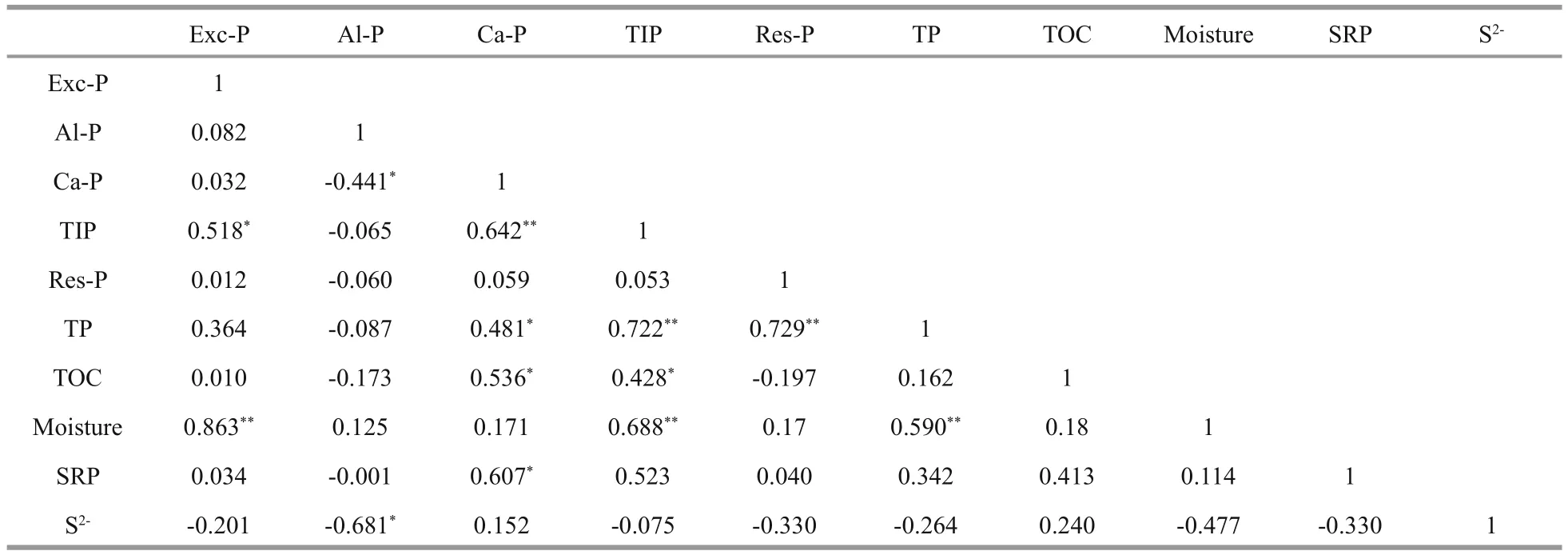
Table 3 Correlation coefficients ( R) among phosphorus species and other parameters of Jintang in winter, Tuohe River
The concentration of TIP varied from 932 to 1 527 mg/kg and the average concentration was 1 198 mg/kg, accounting for 66.7% of TP. Finally, the concentration of Res-P varied from 133 to 1 085 mg/kg with an average concentration of 609 mg/kg,representing 33.9% of TP. The concentration of Res-P generally decreased with increasing depth. As its name indicates this residual fraction is considered relatively inert and not significantly soluble and bioavailable, so its impact on the environment is relatively small.
Overall, the concentration of TP fluctuated from 1 313 to 2 330 mg/kg with an average concentration of TP being at 1 795 mg/kg with again the concentration of TP decreasing with depth. TOP was not detectable in the sediments of Jintang in summer. Li et al. (2004)found that sediments in the absence of organic and inorganic phosphorus contain only a small amount of organic carbon. It indicated the priority of organic phosphorus release from organic matter degradation.
3.1.2 Distribution of phosphorus species in sediment at the Jintang site in winter
Figure 3 presents the concentration of Exc-P,generally decreasing from 41.3 to 11.4 mg/kg with increasing depth, with an average value of 20.2 mg/kg, accounting for only 1.6% of TIP. The moisture content also decreased gradually from 54.9% to 27.4% with increasing depth and TOC remained relatively constant at an average value of 11.4%. The correlation coefficients among phosphorus species and other parameters are shown in Table 3.The higher content of Exc-P in the upper layer of the sediment was in a close correlation with moisture (R=0.863).However, the correlation between Exc-P and SRP (Xu et al., under review) was very poor (0.034), likely revealing that SRP in the porewater has little relationship with the possible release of phosphorus from Exc-P. The main source of phosphorus in the porewater at the Jintang site in winter is from external pollution as documented in an accompanying paper(Xu et al., under review). If we consider the phosphorus content at this site in summer as a background value, we can further speculate that the high phosphorus content in the porewater which came from external pollution had entered the geochemical cycle of phosphorus in the sediments in winter.
The concentration of Al-P averaged 4.65 mg/kg(0.54–8.63 mg/kg), accounting for 0.37% of TIP and showing only small fluctuations with depth. The calculated correlation of -0.681 between Al-P and dissolved sulfide suggests that stronger reducing conditions were more favorable to the release of Al-P in the sediment in winter.
Fe-P was not detectable. Ca-P was again the main component of TIP, with an average concentration of 1 109 mg/kg, representing 89.7%. Its concentration decreased slightly with the increase of depth, before increasing again below -14 cm. The concentration of TIP averaged 1 236 mg/kg, fluctuating between 992 and 1 463 mg/kg, and accounting for 71.0% of total phosphorus TP. The average concentration of Res-P was at 504 mg/kg (ranged from 257 to 898 mg/kg) or 29.0% of TP and that of TP was 1 740 mg/kg (ranged from 1 491 to 2 228 mg/kg).
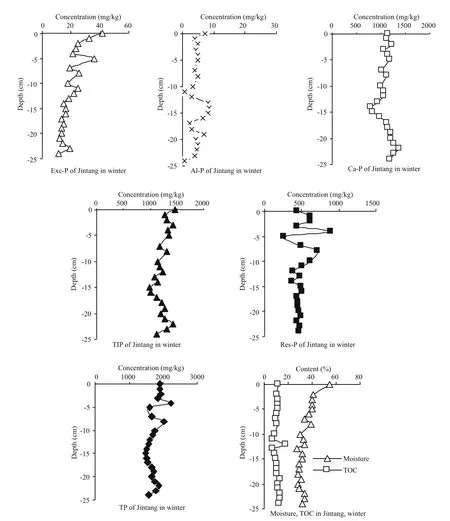
Fig.3 Profiles of phosphorus species, TOC and moisture content in sediment at the Jintang site of the Tuohe River in winter
3.1.3 Distribution of phosphorus species in sediment at the Neijiang site in summer
The profiles of phosphorus species are presented in Fig.4. The concentration of Exc-P oscillated from 11.0 to 38.1 mg/kg, generally increasing with depth.This labile fraction represented 2.5% of TIP with an average concentration of 21.9 mg/kg. The moisture content and the TOC level also increased with depth from 24.0% to 45.1%, and from 3.8% to 30.2%,respectively. These types of profiles increasing with depth at the Neijiang site differ from those at Jintang.The surficial sediments at Neijiang contained more sand than the upstream site, and this is likely the main factor affecting the vertical distribution of the various forms of phosphorus. Due to the large proportion of sandy sediments of the upper layer, the water content and TOC showed an increasing trend downward.From the vertical distribution of the various phosphorus forms, the maximum concentrations were found at around -10 cm where the junction of sandy and less sandy more muddy sediment exist. With a lower water content, sandy sediments have less contact with porewater than muddy sediments, and the exchange with the overlying flowing water is facilitated.
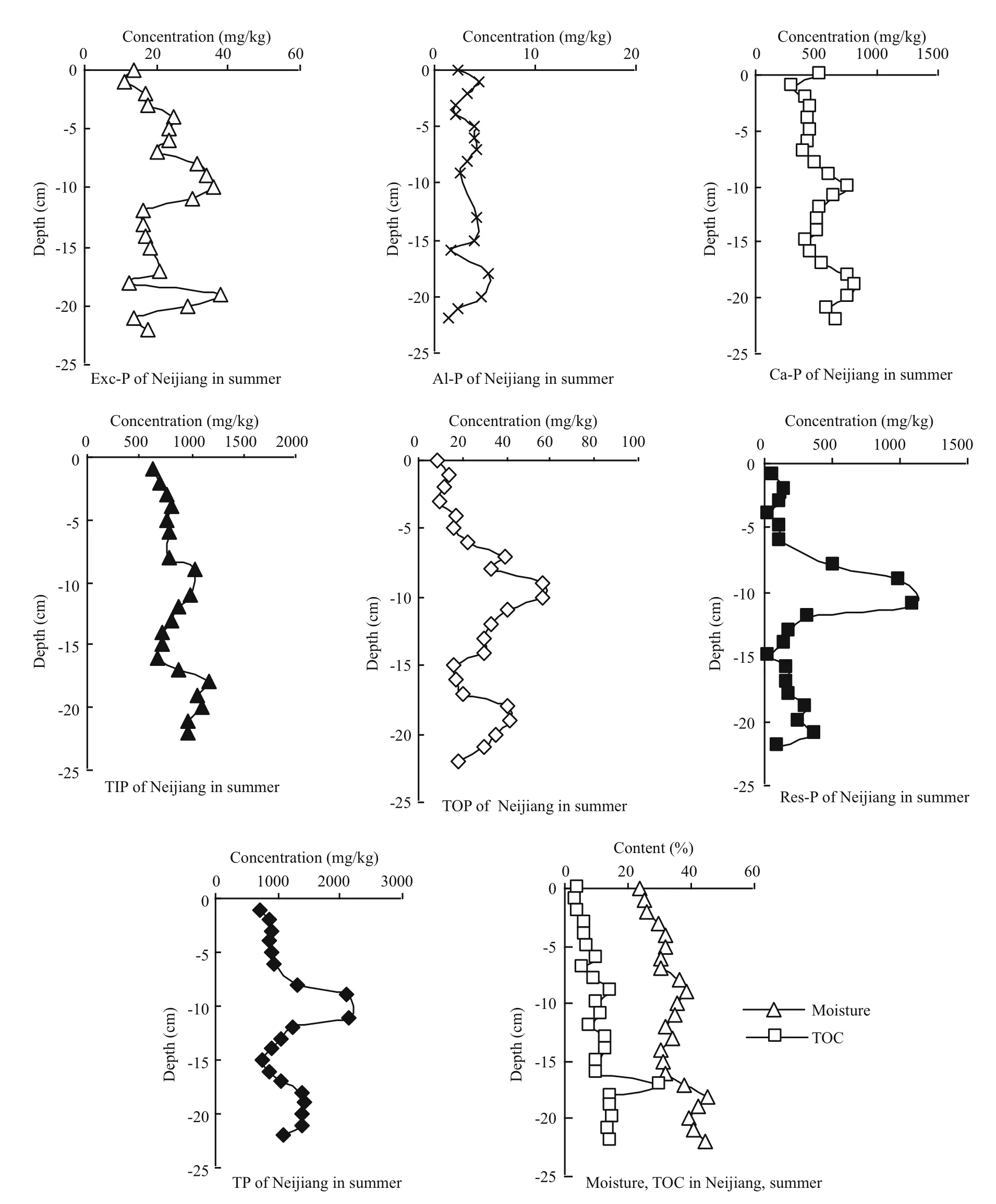
Fig.4 Profiles of phosphorus species, TOC and moisture content in sediment at the Neijiang site of the Tuohe River in summer
The concentrations of Al-P at the Neijiang site were very low (1.3–5.4 mg/kg), representing only 0.38% of TIP. Fe-P was not detectable and the concentration of Ca-P averaged 550 mg/kg,corresponding to 64.0% of TIP and also increasing with depth. The average concentration of TIP of 860 mg/kg represented 77.4% of TP. The concentration of TOP was very low in general, and lower in surficial sediments and only equivalent to 2.5% of TP. It was shown (Pang, 2004) that the SiO2content in sediment was negatively correlated with various forms of phosphorus and that a high percentage of sand in the sediment had a great influence on the distribution of phosphorus, especially for the content of TOP and Ca-P.

Table 4 Correlation coefficients ( R) among phosphorus species and other parameters of Neijiang in summer, Tuohe River
Finally, the concentration of Res-P represented 27.0% of TP with an average value of 301 mg/kg and that of TP averaged 1 111 mg/kg (543–2 128 mg/kg).
The correlation coefficients among phosphorus species and other parameters are shown in Table 4.There were also showed some significant positive correlation between Exc-P and Ca-P (0.481), TOP(0.623), Res-P (0.544) and TP (0.570), and between TOC and Ca-P (0.505), TIP (0.503), and between Moisture and Ca-P (0.775), TIP (0.871), TOP (0.549),TP (0.552) and TOC (0.681). The organic matter controls the vertical distribution of different forms of phosphorus and the migration and transformation between them to some extent.
3.1.4 Distribution of phosphorus species in sediment at the Neijiang site in winter
The main forms of phosphorus as well as the moisture and TOC content all increased slightly with increasing depth at the Neijiang site in winter,similarly to the situation in summer at this location. It suggests that the mechanisms controlling the vertical distribution of phosphorus in sediments are similar to those operating in summer. Those mechanisms are very likely in close correlation with the special physical and chemical characteristics of the sandy sediments at this site. As shown in Fig.5, the proportion of Exc-P corresponded to only 2.0% of TIP with an average value of 16.6 mg/kg whereas that proportion was only 0.42% for Al-P and 0.04% for Fe-P. The largest fraction of phosphorus was still Ca-P representing 80.9% of TIP, which in turn counts for 90.3% of TP. As a result, the proportion of Res-P was only 0.8% of TP.
The correlation coefficients among phosphorus species and other parameters are shown in Table 5.Significant calculated correlations between Exc-P and Fe-P (0.662), TIP (0.765), TP (0.808) and TOC(0.510), and between TIP and Fe-P (0.605) and Ca-P(0.914), and between TP and Exc-P (0.808), Fe-P(0.610), Ca-P (0.807) and TIP (0.925) indicate that the various forms of phosphorus contents are influenced by each other under certain conditions and can be transferred and transformed within the sediment pool of phosphorus.
3.2 Vertical distribution characteristics of bioavailable phosphorus (BAP) at the two sampling sites
BAP was estimated using the method of Liu et al.(2005) by taking 60% of the sum of Exc-P, Fe/Al-P and Org-P. BAP has an important guiding significance in the prediction of the potential ecological risk in the river. Figure 6 shows that the vertical distribution of BAP decreased with the increasing depth at the two sampling sites except for Neijiang in summer. It indicates that with the increase of depth, the phosphorus forms of BAP gets converted to nonactive and less bioavailable phosphorus in the sediment, which is consistent with the conclusions in another recent study (Zhang et al., 2006). The different trend observable at the Neijiang site during the summer is very likely related to the different nature of the sandy sediment at this particular location.

Table 5 Correlation coefficients ( R) among phosphorus species and other parameters of Neijiang in winter, Tuohe River
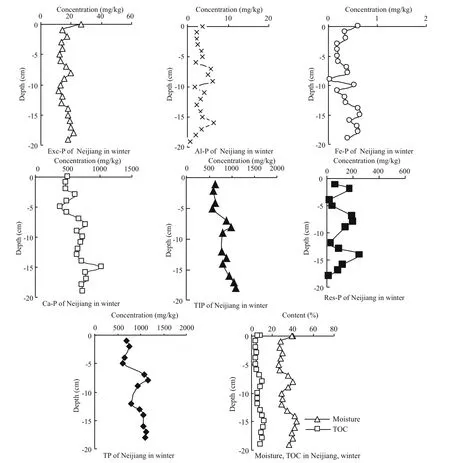
Fig.5 Profiles of phosphorus species, TOC and moisture content in sediment at the Neijiang site of the Tuohe River in winter
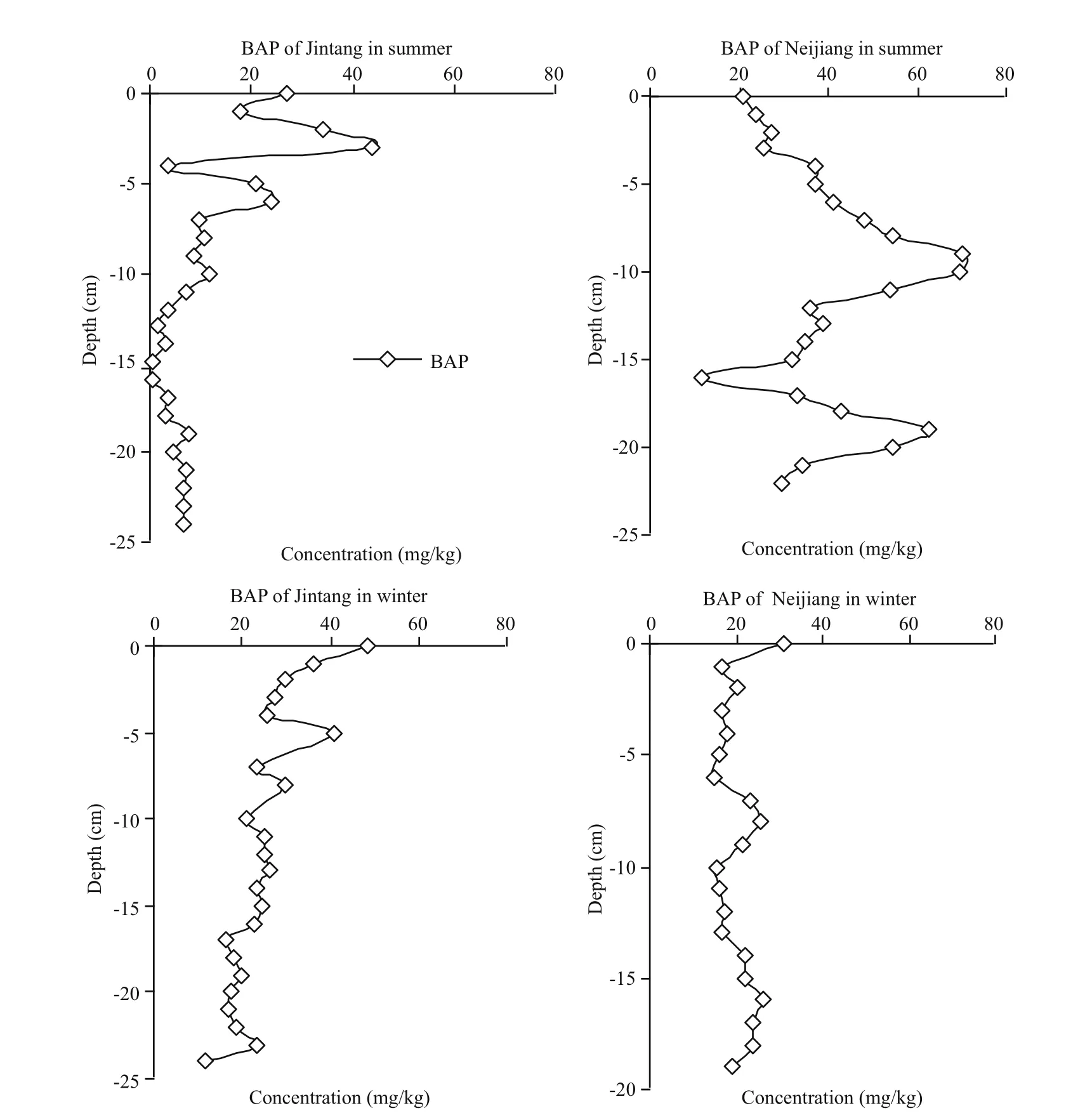
Fig.6 Vertical distributions of BAP in sediment at the two sampling sites of the Tuohe River
3.3 Spatial comparison of phosphorus forms in sediments of the two sampling sites
The average contents of Ca-P, TIP and TP were higher at the Jintang than those at the Neijiang site in both summer and winter due to some local source of pollution at the first site. Studies have shown that with the increase of iron, aluminum, calcium and other metal compounds and organic matter content, the content of Fe/Al-P and Ca-P in the sediments also increased significantly (Igwe et al., 2010; Kleeberg et al., 2013). As shown in Tables 2 to 5, both Ca-P and TOC have a significant positive correlation (except for Jintang, summer). However, the contents of Exc-P,Al-P, Fe-P and TOP showed no clear trend at the two sampling sites, confirming that these forms of phosphorus are easily influenced by external factors such as wind waves and biological agitation, redox state changes, sediment characteristics and microbial activities. These various forms of phosphorus which belong to the BAP are easily absorbed to but also easily released from the sediment.
The average content of BAP was higher at the Neijiang site in summer whereas it was higher at Jintang in winter. Similarly, the content of soluble reactive phosphorus (SRP) (Xu et al., under review)in porewater was higher at the Neijiang site in summer and higher at Jintang in winter, indicating that temporarily and spatially, the BAP in sediments has a close correlation with the SRP in porewater.
3.4 Seasonal variations of phosphorus forms in sediments of the two sampling sites
The main component of TP in the sediments both in summer and winter at the two sampling sites was TIP, many studies have come to the same conclusion(Li et al., 2004; Xiang and Zhou, 2011; Młynarczyk et al., 2013). The difference is the main phosphorus form of inorganic phosphorus is not consistent, which may be related to the difference of composition of sediments and the sedimentary geological conditions in the different study area. In this study, inorganic phosphorus mainly existed as Ca-P. The concentrations of the various phosphorus fractions in sediments of the Tuohe River at the two sampling sites followed this order: TP > TIP > Ca-P > Res-P > Exc-P > Fe/Al-P. Through the comparison of the different forms of phosphorus in sediments in summer and winter we can see that the average contents of TP, TIP and Res-P in winter were lower than those in summer, and the content of Ca-P in winter was higher than that in summer. We suggest that the phosphorus released from the various forms in sediments in summer was converted to Ca-P and returned to the sediments. The content of BAP in winter was higher than that in summer at Jintang, whereas it was higher in summer than that in winter at Neijiang.
4 CONCLUSION
In the sediment samples collected at two sites on the Tuohe River, the concentrations of total phosphorus largely consisted of inorganic forms, and Ca-P was the most abundant fraction of TIP. The contents of phosphorus species in all four sediment cores followed the order: TP > TIP > Ca-P > Res-P >Exc-P > Fe/Al-P, and the concentrations of TP, TIP and Res-P were more abundant in summer than those in winter, whereas the concentrations of Ca-P were inversely more abundant in winter. Total phosphorus(TP) ranged from 1 313–2 330 mg/kg and 1 491–2 228 mg/kg in Jintang in summer and winter respectively; and ranged from 543–2 128 mg/kg and 603–1 175 mg/kg in Neijiang in summer and winter respectively.It can prediceted the pollution of P in Jintang is serious than that in Neijiang in both summer and winter. BAP represented only a minor portion of the total phosphorus as 0.6%–3.6%. A comparison of BAP with the vertical distributions of SRP, which were shown more abundant in the upper layer of the sediment and decreased in depths, suggests that BAP may be converted to non-bioavailable phosphorus and that some fractions of phosphorus are involved in the very dynamic system of the river sediments.
5 ACKNOWLEDGEMENT
Thanks to Dr. WU Y., Ms. WANG S. and Ms.ZHANG R. at Chengdu University of Technology for their active assistance in this work.
 Journal of Oceanology and Limnology2018年6期
Journal of Oceanology and Limnology2018年6期
- Journal of Oceanology and Limnology的其它文章
- Neuroanatomy and morphological diversity of brain cells from adult crayfish Cherax quadricarinatus*
- On the influence of season and salinity on the phenology of invertebrates in Australian saline lakes, with special reference to those of the Paroo in the semiarid inland
- Man-made plutonium radioisotopes in the salt lakes of the Crimean peninsula
- Cladophora mats in a Crimean hypersaline lake: structure,dynamics, and inhabiting animals
- Antimony speciation at the sediment-water interface of the Poyang Lake: response to seasonal variation*
- The characteristic pattern of multiple colored layers in coastal stratified lakes in the process of separation from the White Sea*
